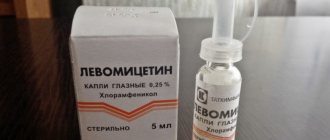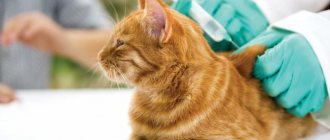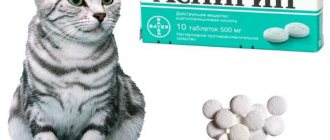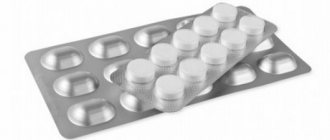Brief description of the drug
The eye drops contain an active substance called sulfacetamide. This drug is mainly intended for people, including it can be used for small children from the first day of life. There are several indications for its use:
- purulent conjunctivitis;
- inflammatory reactions;
- entry of foreign bodies into the organs of vision;
- ulcerative lesion of the cornea of the eye.
In addition, this drug is also used to prevent infectious or bacterial diseases of the organs of vision. But it is not as safe as it seems; side effects such as excessive lacrimation, itching and burning sensations, the appearance of a rash or red spots on the skin around the eyes, or pain in the visual organs are possible. Therefore, you should be careful about its use and first study the question of whether Albucid can be dripped into a cat’s eyes.
Side effects
When instilling the drug Sulfacyl - Sodium into the eyes, the following side effects may occur:
- burning;
- lacrimation;
- pain in the eyes;
- itching;
- allergic reactions.
Some owners use the drug Sulfacyl-Sodium for inflammation of the mucous membrane of the cat's eye, however, when instilling Albucid in kittens once a day, they do not know how many drops are needed in one eye. They believe that the medication dries out the mucous membrane and stops lacrimation. Your pet may experience a sharp deterioration in vision after such treatment.
When using the medicine, you may encounter negative side effects such as blindness. Frequent use of the drug leads to an overdose, pain and severe burning are felt.
In this case, you need to consult a doctor, change the treatment regimen or discontinue the medication. Side effects are pronounced if the drug has expired and its physical properties have changed.
Frequent phenomena after instillation of the drug are considered to be:
- photosensitivity;
- fever;
- redness of the sclera;
- edema;
- allergic myocarditis.
Kittens have more sensitive eyes, and after using Albucid they often develop keratitis.
20% Albucid is diluted with boiled water in a ratio of 1:3, 1 part of the drug is taken into an eye dropper, and 1-2 drops are injected into the pet’s sore eye. During the procedure, the animal behaves aggressively, bites, and scratches.
The medicine is used if the cat needs urgent medical care and there are no other eye drops. For viral infections, complex treatment is carried out; Albucid drops can only worsen the situation.
If a person has a pet, then he undertakes to bear full responsibility for its health, including treatment. The sore spot for many furry animals, especially in adulthood, is the eyes. That is why many owners are tormented by the question of whether it is possible to drip Albucid into the eyes of cats. It's worth looking into this in more detail.
Why can't cats be given Albucid?
Any qualified veterinarian will give a definite answer: Albucid as a medicine is strictly contraindicated for cats! There are a number of objective reasons for this:
- The drug is intended for the treatment of human pathologies.
- A person and a cat have completely different physiological features of the structure of their visual organs. For example, cats have a third eyelid, which provides additional protection to the eye, which cannot be said about the human eye. Due to the huge difference in the biological and anatomical structures of humans and cats, it is completely unacceptable to use the same drugs to treat two organisms that are dissimilar in structure.
- For the treatment of pets, special drugs have been developed that are in no way inferior in effectiveness to those used in human treatment. It is strictly forbidden to drip Albucid into a cat’s eyes when you can use alternative products for cats and dogs, such as “Dekta-2”, “Anandin”, or “Tsiprovet”. These medications will quickly eliminate the inflammatory process in your pet and will not harm him. Don't forget that some medications used by people can lead to the death of a pet!
- The components of Albucid drops cause a painful burning sensation in the cat's eyes, since the eyes of the animal are more sensitive than those of humans. This medicine can easily burn your pet’s cornea and, thereby, aggravate the situation of the sick cat. The use of Albucid, even with a low content of the active component, can lead to an overdose and painful side effects, including loss of vision.
- Often, some owners drip Albucid into the cat's eyes due to the availability and low cost of the medicine. Indeed, the price range of “human” drugs, such as chloramphenicol, for example, is significantly lower than their “feline” counterparts. The desire to save money and lack of time to visit the veterinarian can lead to dire consequences for the health of your pet. All warnings about the dangers of self-medication apply not only to the person himself, but also to our smaller brothers!
- Some cat owners claim that the use of Albucid has no harmful effects on the cat's eyes, especially if you use children's Albucid with a gentle content of the active substance. Children's drops of this drug contain a ten percent concentration of the active ingredient, so other breeders do not see anything wrong with putting Albucid in a kitten's eyes.
How to treat your pet is up to you! However, do not forget about one very important nuance. It is impossible to accurately predict the reaction of a pet’s body to the use of products intended for human treatment. It is much safer to purchase special medications for animals in specialized veterinary pharmacies.
Instructions for use
Using this product for cats requires extreme care. First, Albucid is applied to a cotton swab, with the help of which purulent formation is removed from the eyes. Next, using a cotton swab, the medicine is applied to the corners of the eyes, to places where inflammation and redness are observed.
Treatment is carried out about 3 times a day, but only if increased suppuration and damage to the eye area is recorded. Otherwise, your cat should be given Sulfacyl only on the first day.
The problem is that pets, like a small child, do not like this “operation”. The animal is disgusted by the smell, so the owner will have to be patient to carefully apply the drug and not injure the cat. Recovery time varies from 2 to 5 days depending on the level of eye damage.
Particular care is taken when a dog or cat’s eye does not open due to suppuration. Do not try to open your eyelids. This can lead to damage and injury to the affected areas and disturbances in the structure of the mucosa.
Veterinarians recommend moistening a cotton swab in warm water and gently treating the “crusts” of the cat’s eyes. The eyelids open randomly when the dried crust is partially dissolved. Next, Sulfacyl is instilled.
Expert opinion
Any cat diseases, including eye problems, are dealt with by veterinarians. They strongly do not recommend dripping Albucid into a cat’s eyes for several reasons:
- This drug is intended only for humans, and the structure of their visual organs is noticeably different from the structure of the visual organs of cats. Therefore, absolutely any human medicine is contraindicated for them, even if it has the most gentle composition.
- Many cats cannot tolerate the component included in its composition. This means that it will not only not have a positive effect in treatment, but will also lead to unwanted side effects and negative consequences.
- A pet's eyes are much more sensitive than a person's. That is why they are protected by an additional eyelid. After instilling Albucid into a cat's eyes, you may notice that it is experiencing unbearable pain, and the burning sensation can be so strong that the pet will completely lose the ability to see.
Many owners of furry animals claim that they were completely able to cure their cat’s eyes with a similar drug intended for infants. But veterinarians say that this is impossible to do, if the eye drops helped, this was only an isolated case of all possible cases.
Albucid is an eye drop. The main purpose of the drug is to treat certain eye diseases of an infectious nature. Its use is also indicated for inflammatory processes in the organs of hearing and smell.
In particular, albucid is prescribed for preventive purposes, as well as to get rid of the following ailments:
- otitis;
- persistent rhinitis;
- adenoids;
- blepharitis;
- conjunctivitis;
- other infectious eye diseases.
But the drug should be used in case of rhinitis in a child only after consulting a doctor.
Albucid does not have a vasoconstrictor effect, is not characterized by the occurrence of dependence, it is effective in the fight against microbes, and relieves acute inflammation. It is also a good drying agent.
The use of Albucid for the nose can serve as both an auxiliary and the main method of fighting infection; it is also appropriate to use it for acute sinusitis.
The nasal method of using these eye drops is not described in the instructions for them. And yet, the drug is effective not only in ophthalmology. Is it worth using Albucid nasally in the case of a child? Experienced specialists answer this question in the affirmative, since there are reasons for this.
We suggest you familiarize yourself with: American Akita or Large Japanese Dog
But still, despite the fact that the list of contraindications for drops is not very extensive, most pediatricians are inclined not to recommend Albucid for instillation into the nose of infants.
And there is no connection with the side effects of the drug.
Rather, Albucid is not recommended due to possible injury to the mucous membrane when using a pipette (although you can wipe the baby’s nasal passages with a cotton swab, moistening it in the drug solution).
Often this particular drug helps to get rid of those symptoms that cannot be treated with antibiotic drops. This happens because the spectrum of flora that is sensitive to Albucid is quite wide. While many antibiotics only get rid of certain bacteria.
The drug not only relieves discomfort, it actually heals.
The medicine is characterized by a low degree of distribution in the body, since the effect is predominantly local, in particular where it was administered.
Before instilling Albucid into a child’s nose, you should definitely clear the nasal passage of accumulated mucus. If the child is already able to blow his nose on his own, let him do it.
And very young children can be cleaned using a weak saline or saline solution.
Rinsing the nose is carried out with a regular cotton swab, which is moistened in one of the above solutions.
Note that for children, drops in the form of a 20 percent solution are indicated for the treatment of bacterial infections. To avoid a possible burning sensation, the concentration of the composition is reduced with ordinary boiled water. To do this, the product is diluted in water (1:1). A single dosage is usually 2 drops in each nostril.
3–4 instillations are performed daily; it is important to maintain equal time intervals between procedures. Treatment usually lasts from five days to a week. However, in each specific case, the required duration of therapy should be determined exclusively by the pediatrician. He also specifies the intensity of treatment.
A considerable part of doctors (including the authoritative pediatrician Komarovsky) believes that using Albucid nasally is a waste of both time and money.
In particular, Komarovsky refers to the following: once the drug gets into the nose, it simply does not have time to dissolve in order to begin to act effectively. The medicine quickly moves into the pharynx, and if the child swallows it, it also enters the esophagus.
To the logical question - for what reasons do many pediatricians prescribe this drug for rhinitis - Komarovsky gives the following answer. He believes this appears to be due to treatment faking.
Usually, in most cases, a child's runny nose is viral.
However, if the doctor says that he will not prescribe anything, the child’s mother will doubt his competence and may complain to higher authorities. Therefore, it is easier for the pediatrician to prescribe the same Albucid, which may not be beneficial, but also will not cause harm.
As a result, the child will recover on his own, as it should be. The doctor’s reputation will not suffer, and parents will be confident that it was Albucid who helped the baby recover. Thus, the situation is convenient for everyone.
Komarovsky advises not to waste time, but to properly treat a child’s runny nose, creating optimal conditions for his recovery. In particular, maintaining the necessary microclimate will help you recover faster: daily wet cleaning of the room and ventilation, air temperature up to 20° C, humidity (up to 70%).
But if there is still an urgent need, then nasal drops should be used as prescribed by the pediatrician - Nazol or Nazivin.
Often, as an option, doctors also prescribe medications intended exclusively for eye therapy: the same Ophthalmodec or Tobrex. Naturally, these drugs do not require instillation into the nose.
Official medicine does not agree with the methods of treating rhinitis proposed by Komarovsky. Many doctors appeal to the fact that not a single medical manual or textbook makes reference to the use of Albucid as a drug for the common cold. Therefore, a doctor cannot prescribe a drug with no proven effect anywhere.
Let’s say rhinitis is caused by bacteria, but they gradually adapt to this remedy, and its subsequent use against other diseases (the same eye treatment) will not be effective.
It is also very important to get samples of your baby’s nasal secretions. The doctor must be sure that the infection is actually bacterial. The necessary studies are carried out over 4 days. During this period, rhinitis may go away.
The child’s parents should consult with a pediatrician, clarify the cause of the illness, and only then determine who should be trusted: Dr. Komarovsky or official medicine. After all, every parent is responsible for the health of their child.
Main causes of the disease
This aspect deserves special attention. Before we talk about how to treat conjunctivitis in a cat, let's first understand why it develops. There can be quite a few reasons, since animals have a very weak cornea.
The nature of the occurrence of this disease is as follows:
- Infectious:
-viral;
-fungal;
-bacterial.
- Allergic.
- Traumatic.
To understand how to treat conjunctivitis in a cat, you must first find out what caused it. Based on this, medications are selected. It is difficult to determine the cause on your own, so you should consult a veterinarian. You cannot delay this for too long, since the disease can develop into a chronic form and periodically manifest itself in the form of relapses.
How to administer drops correctly?
The presence of ocular inflammation is an indication for the use of certain drugs, among which Albucid drops occupy a special place.
They can be used for keratitis, conjunctivitis, blepharitis and other eye diseases.
Thanks to this product, antibacterial and antiviral effects are ensured; the process of producing interferon, which is responsible for the destruction of pathogenic microorganisms, is launched in the cornea.
The pharmacological drug belongs to the group of antibiotics and is usually used to treat eye pathologies. The action of Albucid is aimed at treating and preventing the development of inflammatory processes.
Drops quickly enter the tissues of the organ of vision and suppress the proliferation of pathogenic bacteria.
A local remedy is used to relieve inflammation in the anterior part of the eye, which occurs as a result of infection there, the pathogens of which are very sensitive to the substance sulfacetamide. The bacteriostatic effect of the drug is effective against the following bacteria:
- actinomycins;
- chlamydia;
- cocci;
- coli.
Drops should be used at the beginning of an eye disease, when primary symptoms begin to appear - burning, lacrimation, pain in bright light, itching. The drug is used for:
- purulent ulcerations of the eye membrane;
- conjunctivitis of any type, including those caused by organ injury;
- blepharitis;
- barley (inflammation of eyelash bulbs);
- blenorrhea;
- after eye surgery;
- keratitis;
- gonorrheal lesions of the organs of vision.
We suggest you read: What fluid in a cat’s stomach indicates. Fluid in a cat’s stomach indicates an infection.
For the nose
Albucite drops are used not only to treat the eyes, but also in the presence of a runny nose or sinusitis. The effectiveness of the drug for the treatment of such diseases is explained by the inability of bacteria to quickly adapt to the active components of the solution.
In addition to the antibacterial effect, Albucid has a drying effect on the mucous membrane of the nasal sinuses, due to which the product reduces the volume of mucous secretions.
Despite the relative safety of the drops, they should be used with caution and only after a doctor’s prescription.
Mechanism of action
The active component of the medicine is sulfacetamide, which has a pronounced bactericidal effect.
The substance quickly dissolves in liquid media, due to which it penetrates well into the tissues of the organ of vision, after which it immediately begins to exhibit a local effect.
Sulfacetamide destroys bacteria, stopping their development and reproduction, which is achieved by disrupting the supply of nutrients to pathogenic microorganisms. As a result, the membrane is destroyed and the bacteria subsequently die.
Compound
Instillation of drops is advisable for the prevention and treatment of eye inflammation, and the product can be used for conjunctivitis, keratitis and other eye diseases.
Albucid also has an immunostimulating effect, so the solution is prescribed after surgery. The medicine is released in bottles with a concentration of 20 and 30%, a volume of 5 and 10 ml, equipped with a convenient dispenser on top.
The main active ingredient of the drug is sulfacetamide, additional components are:
- hydrochloric acid;
- sodium thiosulfate;
- distilled water.
In the presence of an inflammatory process in the acute stage, the drug should be used 6 times a day, with a couple of drops dripped into the cavity between the eye and the eyelid or onto the organ of vision itself.
As the severity of symptoms decreases, the frequency of taking the drug is reduced to 4-3 per day. As a rule, treatment of eye diseases with Albucid is carried out for a week, in rare cases extending it to 10 days.
The drug can be stored for no more than 28 days.
According to the instructions for the product, before using the drops, hands should be washed with soap. It is better to carry out the instillation procedure in a lying or sitting position, with your head thrown back.
The bottle with the solution is taken in one hand, and with the other it is necessary to pull back the lower eyelid, forming a cavity into which the medicine should be dripped.
After completing the procedure, you need to close your eyes, and lightly pinch the corner of your eye closest to the bridge of your nose with your middle finger (this way drops of sodium sulfacyl will not get into your nasal sinuses).
Albucid is used in the eyes of newborns to prevent gonococcal conjunctivitis. For this purpose, the solution is instilled into the baby in the maternity hospital twice - immediately after birth and another 2 hours later.
Is it possible to drip Albucid into the nose of children? From a very early age, children can have the solution instilled into their sinuses to eliminate snot.
Parents often use Albucid for runny noses in children, since the drug is not addictive and has a targeted effect on the bacteria that cause the disease.
However, such a therapeutic measure can only be carried out with the permission of a doctor. In this case, drops can be prescribed to both infants and adolescents.
Since sulfacetamide does not affect the microflora of the nasopharynx, the solution is not capable of causing an allergic reaction.
During pregnancy
The frequency of use of drops for a pregnant woman is prescribed by the doctor, guided by the severity of the symptoms and the type of pathology.
If the patient has acute conjunctivitis, the drug is instilled 5-6 times a day, 2-3 drops into each eye. As the negative effects decrease, the frequency of use of the drug is reduced.
It is prohibited to use the solution without consulting a doctor, since such treatment can negatively affect the child.
Specialists, in addition, can prescribe the use of a remedy for the treatment of a runny nose, but this can only be done in the case of purulent rhinitis with the addition of a bacterial infection (in this case, the discharge becomes green).
In the case of treatment of a disease whose appearance has barely begun, it will not be possible to get rid of a runny nose with drops, since the infection has not yet had time to spread to the sinuses.
At the same time, the use of Albucid will only help the virus acquire resistance to the drug.
Contraindications
If there is a high sensitivity to sulfacetamide, doctors do not prescribe Albucid eye drops to patients. In addition, the solution should be used with caution in those people who have previously been allergic to ACE inhibitors, antidiabetic agents and diuretics.
During Albucid therapy, it is recommended not to wear contact lenses, as they will lose their transparency. The presence of purulent conjunctivitis is a good reason to temporarily replace them with glasses. The drug should be used with caution in parallel treatment with agents containing silver ions.
Side effects
In rare cases, drops cause eye irritation, which is manifested by severe tearing, burning, and itching. If you experience similar symptoms during treatment with Albucid drops, you should seek help from a specialist. In addition to the listed side effects, the solution may cause:
- various allergic manifestations;
- swelling of the conjunctiva;
- itching of the skin of the eyelids;
- hyperemia of the conjunctiva.
Overdose
Frequent or excessive use of Albucid irritates the eye membrane, so if redness, itching, or clear discharge occurs, reduce the dosage of the drug or reduce the concentration of the drug from 30 to 20%. Accidental ingestion of drops causes the following negative effects:
- vomiting;
- nausea;
- confusion;
- drowsiness.
Eye drops should not be used simultaneously with any other local solutions containing silver compounds.
Albucid should not be prescribed if the patient wears contact lenses and cannot remove them during therapy.
We suggest you familiarize yourself with: How many nipples does a cat have, their structure and functions
In addition, if the patient has signs of sensitization to sulfonamide medications and hypoglycemic drugs, a cross-allergy to Albucid may occur.
The eye solution is highly effective and low in price, so it outperforms most of its analogues. However, sometimes the drops cannot be found in the pharmacy, then they can be replaced with one of the following drugs:
- Tobrazon;
- Phloxal;
- Stillavit;
- Torbex;
- Normax;
- Okumed.
The main purpose of the medication is the treatment of eye pathologies and their prevention, however, due to its availability and universality of effect, Albucid can be used to treat the runny nose.
The drug can be purchased inexpensively at the pharmacy in the form of a spray, drops, or even ampoules for intravenous injection. In addition, the product can be purchased in the online store by ordering targeted delivery.
How much does Albucid cost? The average cost of drops is 50-60 rubles.
: Albucid drops
The information presented in the article is for informational purposes only. The materials in the article do not encourage self-treatment. Only a qualified doctor can make a diagnosis and make recommendations for treatment based on the individual characteristics of a particular patient.
- The patient should be placed on a pillow. Healthy care is below.
- Retract the auricle and inject the required amount of the drug.
- The dosage is determined by the attending physician, who is based on the intensity of the inflammatory process.
- Adults are usually given 2-3 drops at a time
- Infants are prescribed 1 drop at a time.
As soon as you finish administering the drug, experts advise massaging your ear for 10-15 minutes. This is done for better absorption of the medicine. To avoid complications and keep warm, the ear opening should be closed with a cotton swab or a small cotton ball.
The course of treatment is determined by the attending physician. As a rule, with otitis, it is 7-10 days. If your symptoms go away immediately after taking the drug, you do not need to stop treatment, as the pain will appear again if the inflammatory process is not treated.
If doctors diagnose purulent otitis, they prescribe 30 percent drops with turunda placed in the ears for 30-40 minutes. After removing the ear swabs, the ears should be rinsed with warm water and wiped dry.
Washing
Treatment of conjunctivitis in a cat is best done by a veterinarian. Having noticed the first signs of the disease, you should immediately show the animal to a specialist. In an advanced form or with an acute course of the disease, there is a high probability of developing many serious complications.
But before going to the clinic, you can provide your pet with pre-medical care, which will slightly improve his well-being. The most effective way is to wash the eyes with herbal infusions, such as chamomile or calendula. The liquid should not be too hot or cold. You can also use strong black tea for the procedures.
How to wash a cat's eye with conjunctivitis to quickly overcome the disease? The best option is a solution of furatsilin. To prepare it, you need to dilute 1 gram of the drug in 5 liters of warm boiled water. Some people claim that you can use potassium permanganate, but veterinarians do not advise doing this because it dries out the mucous membrane too much, and in high concentrations it can leave burns.
Another good rinse is boric acid. It is diluted with water at the rate of 1/2 teaspoon per 200 milliliters of water. To relieve pain, two drops of two percent Novocaine are dripped into each eye twice a day. This drug also relieves swelling well.
But don’t stop at just rinsing. Self-medication should not be carried out, as it can distort the clinical picture, which will negatively affect the results of future therapy.
ALBUCID (Sodium Sulfacyl) /
- Medicines Obstetrics and gynecology
- Anesthetics
- Antibacterial, antimicrobial and anthelmintic drugs
- Hepatotropic agents
- Homeopathy
- Dermatology
- Immunotropic agents
- Treatment of the gastrointestinal tract
- Oncology
- Ophthalmology
- Rheumatology, neurology
- Respiratory and antihistamines (antiallergic)
- Cardiovascular and diuretic drugs
- Metabolism
- Urology and means of correcting sexual function in men
- Central nervous system and drugs used to treat smoking, alcoholism, drug addiction
- Endocrinology
- Antifungal
- Accessories for feeding
- Glucometers
- First aid kits
- Lubricants
- Cotton wool, cotton swabs
- Medical procedures
Useful materials:
- Cutaneous horn General description of the disease Cutaneous horn on the forehead or face (ICD 10 code - L57.0) -...
- Itching and odorless discharge Main causesBefore considering the factors that provoke the appearance of discharge that has a sour odor, it is necessary to immediately note...
- Discharge in women What kind of discharge between menstruation is considered normal? Female discharge normally consists of mucus from the cervical canal, dead...











